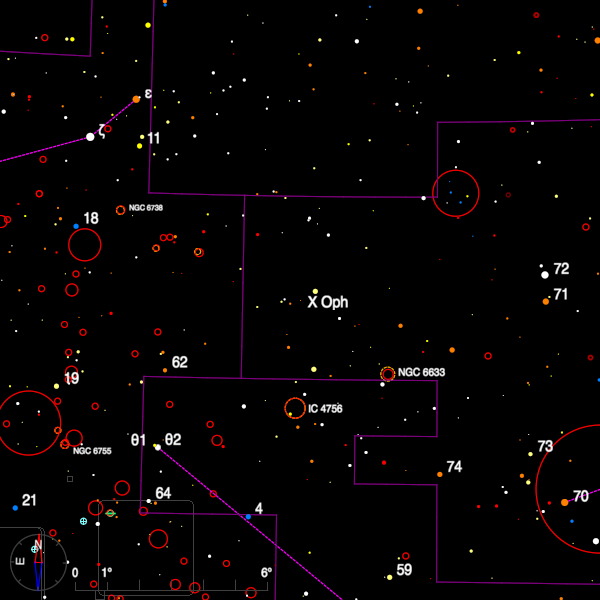July 2020 - Double Star of the Month

Mira was not the first Long Period Variable to be shown to be a visual binary. T. H. E. C. Espin found X Oph (18 38 21.13 +08 50 02.6) in 1886 and in 1900 William Hussey, observing at Lick Observatory, noted that the star was a close pair and catalogued it as HU 198. On several nights with the 36-inch refractor he saw two equally bright stars at a separation of 0".2. Later spectroscopic observation showed that the star spectrum was composite with a K giant combined with an M6 giant. George van Biesbroeck, when observing X Oph visually noted its very deep orange colour.
Since then the stars have separated somewhat and in 2018 the companion was found to be at 126 degrees and 0".5. This fact, and also that X Oph has only a 3.3 magnitude amplitude, and the companion is significantly brighter than Mira B makes this star easier to resolve than Mira, although at least 30-cm would be needed, preferably.
An ephemeris for X Oph gives a maximum brightness on Feb 5, 2020 and Jan 8, 2021 so during July 2020 the variable should be near minimum and therefore helps visual resolution. It is also 10 degrees higher in the sky than Mira. X Oph can be found 4 degrees due north of the open cluster IC 4756 or 18 degrees due west of Altair. According to David Boyd of the BAA Variable Star Section, the primary ranges from V = 6.5 to 9.8 whilst the B star is magnitude 9.0. Gaia DR2 gives a parallax for the variable of 4.66 ± 0.30 mas or 700 ± 45 light-years but there is no entry for the companion.

SEE 316 (17 00 26.96 -48 38 52.2) is in northern Ara and lies 2.5 degrees due east of DUN 211 which was described in May's column.
A discovery of T. J. J. See, this fine pair can be well resolved in 15-cm. The stars are magnitudes 6.3 and 7.7 according to the Washington Double Star Catalog (WDS) and when the writer last measured them in 2016 the position angle and separation were 173 degrees and 1 arc-second. This represents a small increase in angle and a doubling of separation since the first observation in 1897.
Hipparcos gives a distance of about 350 light-years but with a significant error. Surprisingly, the stars do not appear in the Gaia DR2 catalogue even though significantly closer pairs are included. E. J. Hartung noted that the field is rich in faint stars.
Bob Argyle - Double Star Section Director